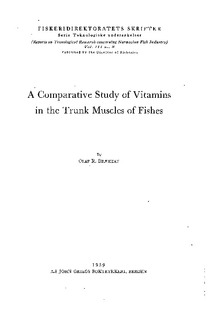| dc.description.abstract | A comparative study of vitamins in the trunk muscles of fishes is reported. The investigation comprises two separate studies. Firstly, the relation between the activity of different species and the average vitamin contents of the whole muscle was studied. Secondly, the relation between the vitamin contents of the red and ordinary muscles were studied in several species, and a proposal is put forward as to the possible function of the red muscle in fish. All B-vitamins investigated were determined by microbiological methods, and the results are reported per g fresh weight as well as per g protein. In addition analyses of moisture, protein, fat and ash are reported in the second part of the study. Single samples of the total trunk muscles from 19 cods weighing from 0.5 to 7. 7 1 kg were analysed on niacin, pantotheic acid, riboflavin and vitamin B12. No relation could be observed between the weight of the fish and the vitamin contents of the muscles. Altogether 15 species were studied with regard to their relative contents of niacin, pantothenic acid, riboflavin and vitamin B12 in the trunk muscles. In general, there seem to be a significant relation between these vitamin contents and the activity of the fishes. The relation was mainly pronounced for species of the same type with regard to external anatomy. Flatfishes were therefore reported as a separate group. In seven species the relations between the contents of niacin, pantothenic acid, riboflavin, vitamin B12 and thiamine in the red and ordinary muscles from the same fishes were reported. The anatomical arrangement and the general histology of the different muscles were briefly described. In addition, analyses of livers from the same species were carried out. The results show that, with the exception of niacin, all other vitamins investigated are present in much higher concentrations in the red than in the ordinary muscle. The general feature of the distribution was very similar to the conditions prevailing in the liver. In most fishes the red muscle had a much higher fat content than the neighbouring ordinary muscle. The results are discussed in relation to other findings reported in the literature with regard to the relative distribution of vitamins and enzymes in the red and ordinary muscle of fish. It is proposed that the main function of the red muscle is not muscular activity, but the function of an organ able to carry out several metabolic processes normally taking place in the liver. | no_NO |
